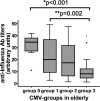Intensity of the humoral response to cytomegalovirus is associated with the phenotypic and functional status of the immune system
- PMID: 23388717
- PMCID: PMC3624366
- DOI: 10.1128/JVI.02425-12
Intensity of the humoral response to cytomegalovirus is associated with the phenotypic and functional status of the immune system
Erratum in
- J Virol. 2013 Aug;87(15):8816
Abstract
Cytomegalovirus (CMV) infection exerts an enormous effect on human immunity, as it is associated with an immune-impaired response, a variety of chronic diseases, and overall survival in elderly individuals. Levels of anti-CMV antibodies may be associated with the differentiation degree of T cell subsets. Titers are significantly higher in the elderly and positively correlated with specific CD4(+) T cell responses to CMV. In the elderly, antibody titers are associated with the degree of differentiation and the T cell receptor excision circle (TREC) content in CD4(+) T cells, with other features of the immune risk profile, and with a reduced ability to respond to immunization in vivo. Associations may be absent in young subjects because their anti-CMV antibody titers are lower than those of the elderly. However, comparing young and elderly individuals with similar antibody levels reveals differences in their highly differentiated and naïve T cells. These are more marked in individuals with high titers. In parallel with the increase in anti-CMV antibodies, the elderly experience a significant reduction in absolute counts of naïve CD4(+) T cells, which may be a strategy to compensate for the expansion of differentiated cells and to avoid an increase in total T cells. In summary, our results show that titers of anti-CMV antibodies, and not only CMV seropositivity, are related to differentiation status and immunocompetence in the elderly, making this as an important prognostic marker of the status of immune system function.
Figures






References
-
- Kutza AS, Muhl E, Hackstein H, Kirchner H, Bein G. 1998. High incidence of active cytomegalovirus infection among septic patients. Clin. Infect. Dis. 26:1076–1082 - PubMed
-
- Prösch S, Wendt CE, Reinke P, Priemer C, Oppert M, Kruger DH, Volk HD, Docke WD. 2000. A novel link between stress and human cytomegalovirus (HCMV) infection: sympathetic hyperactivity stimulates HCMV activation. Virology 272:357–365 - PubMed
-
- Aiello AE, Haan M, Blythe L, Moore K, Gonzalez JM, Jagust W. 2006. The influence of latent viral infection on rate of cognitive decline over 4 years. J. Am. Geriatr. Soc. 54:1046–1054 - PubMed
-
- Harkins L, Volk AL, Samanta M, Mikolaenko I, Britt WJ, Bland KI, Cobbs CS. 2002. Specific localisation of human cytomegalovirus nucleic acids and proteins in human colorectal cancer. Lancet 360:1557–1563 - PubMed
Publication types
MeSH terms
Substances
LinkOut - more resources
Full Text Sources
Other Literature Sources
Medical
Research Materials

